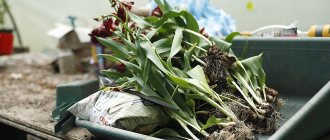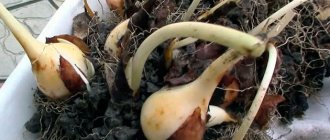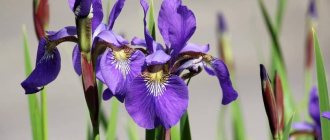General rules for caring for lilies
Lilies belong to the Liliaceae family. These are bulbous plants. And the appearance of this flower largely depends on the quality of the bulb.
Growing a beautiful, lush lily will not be difficult. She prefers morning sunlight, fertile, slightly moist soil with a large humus layer. Therefore, you should choose a place for it where the sun hits in the first half of the day. With a lack of light, these flowers will grow taller, that is, the stem will develop, not the buds.
Lilies do not like acidic soil. Depending on the variety, they require a neutral or slightly acidic environment. Throughout their development, these flowers, like other garden plants, require feeding. Lilies respond well to mineral fertilizers. At the first stage of development, fertilizers containing nitrogen are needed. And starting from the budding period, potassium and phosphorus fertilizers should be added to the soil.
When to prune lilies
Important! Fresh manure should not be added to the soil. Organic matter is not suitable for feeding lilies.
What to do with lilies after flowering
Lilies are beautiful, luxurious, delightful flowers, delighting with their beauty with their variety, variety of colors, captivating with the grace of the curves of each petal during flowering - at the same time proud and strict.
In botany, lilies belong to the Liliaceae family. They have a leafy stem. The lily genus includes more than one hundred species.
These flowers are herbaceous bulbous plants grown in open ground.
When planted by seeds, the period before the first flowers appear can last from three to seven years.
First, it takes several years for the bulb to grow, then a flowering stem appears. This feature makes it necessary to take care of the existing bulbs in order to admire these flowers in your garden next year.
But what to do when the lilies have faded? Do they need to be replanted and what kind of care do they require?
When the lily fades
The flowering period for most lilies is short. After the flowers shed their petals, the plants will require additional care so that they can also delight others next year. What to do with them next?
After the lilies have bloomed, you need to give the plants an aesthetic appearance. Do I need to prune faded lilies and when should this procedure be carried out?
So that dried flowers do not give a dull, depressing appearance, and the bare stem does not stick out alone, it should be trimmed a little. It is impossible to cut the stem short, since the bulb will receive the nutrients it needs at its expense.
If there are still a few flowers left on the plant, they are also cut off. It is important to do this so that the nutrients that are absorbed by the plant from the soil solution are not spent on its flowering, but are deposited in the bulb for better overwintering. This operation is carried out using garden shears or pruning shears, previously disinfected.
This procedure is usually done in mid-autumn. The stem is usually cut at an angle so that water does not accumulate in it, as this can result in rotting of the bulb.
These flowers need sufficient and high-quality feeding. Fertilizers designed specifically for lilies can be purchased in specialized stores. You can use regular humus, but it is worth considering that an excess of this fertilizer can cause burns to the bulbs. In the fall, it is also recommended to fertilize with phosphorus-potassium fertilizers.
It should be noted that lilies are very sensitive, so when carrying out each of the described procedures with them you need to be very careful and careful.
Lilies are perennial flowers, but it is recommended to grow them in one place for no more than 3–4 years. Some gardeners recommend replanting them after each flowering, in case the bulbs will be dug up for the winter.
Bulb storage
Depending on what types and varieties of lilies are grown on the site, an action plan is outlined in relation to their bulbs.
Some types of these flowers are distinguished by good frost resistance and can winter in the ground even in Siberian conditions.
Asian hybrids are able to perfectly tolerate negative temperatures, but for trumpet lilies, for example, such weather conditions are undesirable - they may die.
Therefore, before choosing a method of preparing for winter, you need to study the characteristics of the variety.
If the lilies grown on the site belong to non-frost-resistant varieties, then their bulbs will have to be dug up in mid-autumn and sent for storage in the basement or cellar, where the temperature will not drop below 2 - 3 ° C.
Each variety has its own storage temperature that must be adhered to.
Some varieties of lilies can be simply left in the refrigerator.
To store lily bulbs, sprinkle them with sand, sawdust or earth. If you plan to force lilies in winter, then plant the bulbs directly in a pot with a substrate prepared for this purpose.
You can leave the bulbs in the ground, then you need to create a shelter for them - mulch. For this, leaves, peat, sawdust, bark or other plant debris are used; it is advisable to cover the top with agrotextiles or film.
After the onset of favorable spring temperatures for the plant, the shelter must be removed.
Transplanting lilies
In the autumn, when the lilies have faded and their root system is already dormant, it’s time to start replanting them.
The optimal time for this is a month after flowering, approximately at the end of August or September.
The transplantation will require the organization of the following stages:
- Choosing a location. It is not recommended to grow these flowers in one place for more than 3 years, as this causes soil fatigue and leads to the accumulation of diseases and pests. When choosing a place for planting, it is worth considering that the plant does not like scorching sunlight. Therefore, it is better to plant them where there will be little sun - in partial shade.
- The soil. Lilies prefer well-aerated sandy soils; when planting, it is advisable to add a little humus. But it is better to prepare a special substrate for them from the following components: take sand, peat, sandy clay, pine litter in equal proportions, add two parts of vermicompost (humus can be used) and 4 parts of soil.
- Protection from drafts and wind. It is better to choose a place near a fence or house.
- Preparation of planting material. First, you need to thoroughly check the bulbs; remove rotten and spoiled ones completely so that they do not infect other plants. Next, cut off the broken roots and daughter tubers (so that they do not take nutrients from the main plant), clean the bulb from damaged scales. Disinfect the material intended for planting in a solution of potassium permanganate for half an hour.
Once everything is prepared, you can begin planting.
To do this, holes are made, the depth of which depends on the height of the planting bulbs (the height of two to three bulbs is taken). If the bulb has a powerful peduncle, you can deepen it by 3 - 4 bulbs. It is advisable to adjust the depth to suit the soil structure and the type of lilies being planted. A planting scheme is selected.
Planting is done with the bottom down, then sprinkled with substrate. Next, mandatory watering is required so that the lilies take root as quickly as possible. After planting, it is advisable to note where and what variety the lilies were planted.
Share link:
When to prune lilies
Many amateur gardeners do not know when to remove lilies, so they completely cut off their stems immediately after flowering, that is, as soon as the petals fall. They don’t even suspect that they are causing irreparable harm to their pets.
When to prune irises
After flowering, the process of photosynthesis continues in the stems and leaves. Nutrients continue to flow both through the roots and through the above-ground parts of the plant. If the stems are trimmed prematurely, the bulb will no longer receive some of the nutrients. As a result, its growth may slow down, even to a complete stop. Thus, the bulb may not grow to the size needed to successfully produce flower stalks the following year.
In the first year after planting, lilies have small bulbs. For those who want the young lily to gain strength and please the gardener with luxurious large flowers for the next season, it is advisable to cut off all the buds. In this case, she will receive more nutrients that she needs so much in the first year of life.
Important! If you need to collect lily seeds, do not cut off the flower stalks.
In subsequent years, the bulb will already be acclimatized to soil conditions and there will no longer be a need to cut off the buds during flowering. When should you trim the flower stalks of a lily in this case? After flowering, the petals gradually fall off on their own and only the seed capsule remains on the stem. Then you need to cut off the peduncle. This pruning is mandatory. If you do not remove the seed capsule, all the incoming nutrients will go to the development of the seeds, and not to the development of the bulb. This will also negatively affect further flowering.
Trimming lilies for a bouquet
Bouquets of lilies look luxurious and elegant. Is it possible to cut blooming lilies for a bouquet without causing damage to the bulb? Naturally, yes, but for this you need to pay attention to some nuances:
- For bouquets, you should choose flowers that have 5 or more buds. This is a sign that the bulb has already reached a sufficient size for further development.
- When cutting lilies, you must ensure that the stem remains at least 20 cm high from the ground. This way, the supply of nutrients to the bulb will not stop.
Trimming lilies for a bouquet
- The cut should be made at a slight angle with sharp pruning shears. This way, rainwater will not get inside the stem and the bulb will not rot.
- The cut site should be treated with wood ash for quick healing. This will help avoid rotting of the stem, as well as disease of the entire plant.
Pruning for strong odor
Lilies have a specific, pungent aroma. Not everyone likes this smell. It is especially not suitable for people prone to allergies. Do I need to cut lilies during flowering in this case? After all, the time for cutting the buds has not yet come, and it’s a pity to remove the flowers at the very beginning of flowering.
The aroma of lilies is formed due to volatile oils secreted by all above-ground parts of the plant. The biggest source of odor is pollen, which accumulates on the stamen. Removing it, rather than the entire flower stalk, will help weaken the aroma. To do this, you need to bring a paper bag to the bud and carefully cut off the stamens from it. This procedure should be repeated with each blooming flower.
Important! Lily pollen is poisonous to people and animals, especially cats. Therefore, caution must be exercised. You need to wear gloves to prevent pollen from getting on your fingers. People prone to allergies should wear masks.
After removing the stamen, the scent of the lily will remain, but it will be subtle and unobtrusive.
Trimming stems and leaves
It is necessary to inspect plants as often as possible for the presence of diseased or damaged tops. If detected, they must be removed regardless of the stage of development. You cannot completely cut off all the tops; you should leave as many green and healthy leaves as possible.
Trimming stems and leaves
In some cases, you will have to completely remove the plant:
- If the foliage is covered with specks (spots). This means that the lily has contracted mosaic disease, a viral disease.
- If the bulb or roots are rotten.
If lilies are indoor plants
Many owners of houses, cottages, and apartments grow flowers indoors. They are interested in when the indoor lilies have bloomed and what to do next with them. The processes to which the indoor lily is subject are similar to the changes in lilies growing in the natural environment. House flowers also turn yellow and dry out - first their flower stalks fall off, then the stems turn yellow and dry out. There is no need to touch the plant when it has just begun to bloom. During this period, peace and the correct balance of moisture supply are important for him. Need to:
- reduce soil moisture by increasing the interval between watering to 6-8 days;
- stop spraying with water.
This way it is possible to reduce the activity of processes in the above-ground part of the plant and activate the processes occurring in the bulb.
Bulb
When the ground part of the lily dries out naturally, watering stops completely. The bulb is dug up, cleared of soil and washed with water. Small bulbs are placed in seedling containers with moistened soil. They will gain strength over the winter and in the spring they can be planted in the garden or in houseplant containers to grow at home.
Bulb processing
Large bulbs are carefully examined, damage is removed from them, and the cut area is treated with crushed activated charcoal or charcoal. The stem that has not separated from the bulb is cut off, leaving a part of it up to 6 cm long on the bulb. For disinfection, the bulbs are placed for 25-40 minutes in a solution of potassium permanganate or a fungicidal composition, dried on paper or cloth, and then placed in a bag in a cold place (refrigerator, unheated cellar) until the end of February - beginning of March. In early spring, the bulbs stored in the cold are taken out and planted in a container filled with fertile soil.
Note! Replanting indoor lilies is done annually and each time in new soil.
Bulb storage
Autumn is the time to plant bulbs in containers for winter storage. It is not necessary to plant mature large bulbs. During storage, they can be placed in a box and sprinkled with a mixture of sand, peat, and sawdust. Or put it in a plastic bag and sprinkle with the same mixture. Or make boxes and place them in them, and cover them with moss and burlap on top. Bulbs stored without soil must be dried.
Bulb storage
Then the containers are placed in an unheated cellar or on the bottom shelf of the refrigerator for the entire storage period.
Important! For small onions, planting in the ground for winter storage is mandatory - baby onions that are not strong enough can dry out without soil. They are planted in the ground for winter storage no later than a week after digging up the lily bush.
Transplanting lilies
The lily can be replanted in both spring and autumn. Many gardeners prefer autumn transplanting - it is well tolerated by the bulbs, which are at rest at this time. In addition, in the fall you can combine digging up bulbs for storage and replanting. And plants in a daylily can have different care requirements:
- varieties of Oriental and Orleans lilies that require annual replanting;
- slow-growing varieties that need replanting every 5-6 years;
- American hybrid varieties with a recommendation to replant once every 10 years.
To make a garden with daylilies look attractive, the flowers need to be replanted correctly:
A week before transplantation, the shoots of the flower are cut off so that only a stump remains.
Transplanting lilies
The plant is dug up, cleared of soil and inspected. If there are damaged areas on the bulb (with dark spots, traces of rot), they are cut off.
Important! The tubers are washed in 2 waters and treated in a disinfectant solution of karbofos (1 tablespoon per bucket of water) and left for 30 minutes in a weak solution of potassium permanganate.
Wet bulbs after processing are dried in a dark place at a temperature of 15–18 °C, placed on a wire rack or tray.
Bulbs that have passed all stages can be planted or prepared for winter storage.
How to properly prune a plant for the winter
How to prune lilies in the fall? It was already said above that it is impossible to cut off the ground part prematurely. After flowering, life processes continue in the foliage and stems: under the influence of sunlight, chlorophyll is formed in the leaves, which saturates the bulb with oxygen. Therefore, immediately after flowering ends, the stems and leaves are not removed. They should be removed only after complete drying.
When to prune peonies after flowering
Unlike daylilies, in which the stem is cut off at the root, lilies have part of the stem left. The optimal length that should be left to the ground is 10-15 cm. Pruning is carried out with a sharp, disinfected knife or pruning shears. You must use the tool carefully so as not to cut yourself.
Important! All plant debris after pruning should be burned or destroyed by any available means. Various pests and pathogens can accumulate in them.
For the winter, the area with lilies must be insulated. Fallen leaves are perfect for this. It is not recommended to cover with sawdust, as they tend to freeze.
Fertilizing and other agrotechnical measures
The lily is systematically fed throughout the growing season. The flower also needs feeding after flowering, when the bulb is formed. In the second half of summer, after flowering, the plant needs fertilizers with a high content of potassium and phosphorus. During this period you can fertilize:
- potassium monophosphate at the rate of 25-30 g/m²;
- potassium sulfate (10-15 g/m²);
- superphosphate (20-25 g/m²);
- wood ash (100-150 g/m²);
- humus (bucket per 1 m²);
- special fertilizers for bulbous crops.
Fertilizer for lilies
Caring for peonies after flowering
It is better to feed the plant with a liquid composition, which is prepared according to the instructions for fertilizer. It is better absorbed.
Important! You cannot feed lilies with manure or compost. From such fertilizing, burns and damage appear on the bulb. The root system becomes vulnerable to pathogens, and, as a rule, the plant dies. You should not feed with nitrogen-containing fertilizers - they slow down the formation of bulbs.
Owners of garden plots and summer cottages are interested in what to do next in the open ground when the lilies have faded. To maintain viability, you need to care for the plant:
- water without allowing the soil to dry out;
- loosen the top layer of soil,
- remove weeds.
How to trim flowers before replanting
When to prune irises after flowering
Lilies can grow in one place for up to 3-5 years. The bulb of this plant quickly produces babies, as a result of which the flowers become smaller. Then it’s time to prune and replant the lilies.
There are two transplant options: in spring or autumn. If further planting is planned for spring, the stems should be trimmed after wilting, leaving 10-15 cm from the ground. This is about a month after complete flowering. Before digging, cut off the remaining part. The bulb should be dug up in September-October, as late as possible after flowering.
The optimal time for transplantation is autumn. In this case, you need to cut the stems at ground level and dig up the bulbs a month after the plant wilts. Then dry the bulbs for 1-2 days, clean them of dry scales, disinfect them in a weak solution of potassium permanganate and plant them in previously prepared soil.
What you need to know about storing and wintering lilies
If lilies are planted in spring, care must be taken to store them throughout the winter months. Cool, dry and well-ventilated rooms (basement, cellar) or the bottom shelf of the refrigerator are suitable for this.
In order for the dug up bulbs to successfully survive the winter, they are placed in shallow wooden boxes (plastic ones are allowed), sprinkled with a mixture of sawdust, peat and coarse sand. The option with boxes is also suitable - for this, the planting material is laid out in layers of sphagnum moss or burlap.
If the bulbs will be stored in the refrigerator, they should be placed in bags with peat or sawdust. You can also use moistened natural fabric in which the lilies are carefully wrapped.
Children separated from the mother bulb tolerate wintering best in the ground, since without soil they often dry out. To do this, they are planted in boxes or pots filled with loose sandy soil and stored at a temperature of +4-+6 degrees.
For areas with mild and warm winters, wintering lilies on the balcony is suitable. The dug up bulbs are planted in pots and stored until spring, transferred to open ground at stable above-zero temperatures.
Pruning indoor lilies
Pruning indoor lilies
Varieties grown indoors go through the same stages of development as lilies grown outdoors: they fade, gradually dry out, and go into a dormant state. Should I prune my indoor lilies or leave the top part to die naturally?
In order to bloom the following year, the bulb must rest and accumulate nutrients. Therefore, if the indoor lily has faded, you cannot immediately cut off its stems. At first, only the peduncle should be cut off. Next, you need to reduce the moisture supply, while simultaneously extending the interval between waterings, and stop spraying. This will speed up the process of accumulation of nutrients in the bulb. The stem is cut only after it has completely dried.
Trimming
It is strictly contraindicated to cut the flower stem itself, even if it seems to you that a faded lily looks untidy and spoils the appearance. The leaves with the stem, participating in photosynthesis, replenish the supply of nutrients in the bulb that is depleted after flowering. Successful wintering and flowering of the next season depend on their quantity. But the upper part of the stem - the peduncle with faded flowers and seed pods - must be removed.
This will encourage the plant to direct its energy not to producing seeds, but to feeding the bulb. The rest of the above-ground part of the stem should remain until it serves its purpose and withers. Then you will need to carefully unscrew it from the bulb or trim it.
German fairy tales say that every lily has its own elf, who is born and dies with the flower.
How to prepare lilies for winter?
Winter-hardy species and varieties of lilies do not need any special preparation for winter, since they survive the cold well under snow cover. Additionally, you can only mulch the soil and spread spruce branches or brushwood for snow retention.
The main difficulties are usually associated not with winter cold, but with a prolonged warm autumn, which provokes premature awakening of the bulbs, although such premature awakening usually does not cause serious damage to a healthy, strong bulb, although flowering next summer may be somewhat weakened.
Step-by-step algorithm
Lily pruning should be done in accordance with the following step-by-step algorithm:
- Prepare a clean and disinfected instrument.
- Wait until the foliage wilts and turns yellow. This usually happens in the fall.
- Trim leaves at ground level.
- Make sure the bulb is not damaged.
- Note the cut foliage. If it's healthy, just throw it in the compost. If the leaves show any symptoms of disease, the foliage should be burned to avoid infecting other garden plants through the spread of infection.
Sick or damaged foliage not only can, but also must be cut off at any time of the year. If this is not done, there is a high chance that the plant will begin to wilt, as healthy foliage will lack nutrients. Essentially, the flower will spend all its energy trying to heal the wilting vegetative mass.
If you notice specks or spots on the plant, there is a high probability that the flower is infected with the mosaic virus. It will not be possible to cure a lily. It will have to be dug up with the onion and burned. This will prevent the infection from spreading throughout the garden. Plants whose roots or bulbs themselves rot are also subject to destruction. Such a lily will not be able to recover.
After trimming the lily, you need to mulch the ground. This is necessary so that the bulbs survive the winter and the flower blooms in the spring. If only the upper part of the plant was pruned, then the remaining part should be wrapped or covered with a thick (at least 7.5-10 cm) layer of mulch (rotted manure or leaf humus will do). If you omit this simple recommendation, the lily will not survive the winter.
Pruning lilies: a universal method
Most varieties of lilies can be pruned using the universal method. But first you need to determine whether your plants require pruning at all. It will be needed to remove damaged and diseased areas of the plant in order to preserve the main vegetative mass.
It should be understood that pruning a flower cannot limit its growth, unlike pruning a bush. That is why, if you think that the plants are too tall for a particular area of the garden, the only solution is to replace them with shorter, or dwarf, varieties of lilies.
If you do not feel the need to prune the plant, it is better to abandon the procedure altogether. Keep in mind that once you remove the foliage, it will be impossible to determine where it grows due to the lack of visible signs above the ground.
Throughout the growing season, wilted lily flowers need to be treated. Immediately after wilting, the plant begins to set seeds. Removing spent flowers will stop the seed formation process. © https://ydoo.info/qa/kak-obrezat-lilii.htmlThis is useful in some cases, as it allows you to:
- prevent the formation of seed skewers (you need to cut so that about one third of the stem remains for the bulbs to accumulate energy);
- protect the flower from wasting energy on seed formation in order to achieve more abundant flowering.
Pruning must be done using clean, disinfected tools. An alternative is to simply pick off the flowers with your fingers.
Remember that it is highly undesirable to prune foliage until it dries out or dies. Lilies are bulbous plants that use their leaves to store sunlight energy and nutrients in the bulbs. Without this, the plant will not be able to survive winter frosts and then be reborn next spring.
In addition, the accumulation of nutrients in the foliage stimulates the bulb to divide. This helps to propagate the plant, of course, if required. This is why you should not trim the leaves too early, as this will deprive the bulbs of nutrition and additional energy. Pruning is done after flowering has ended, when the foliage begins to wither and die. The latter is a signal that the bulb has accumulated everything it needs. This often happens in the autumn.
If necessary, you can transplant the lily into a container to hide it from prying eyes if it is considered that the plant looks unaesthetic. But remember that the plant still needs full sun or partial shade (only for areas with a hot climate).
To make the lily look aesthetically pleasing even after flowering has finished, you can plant other plants around it, for example, gypsophila or sage.











